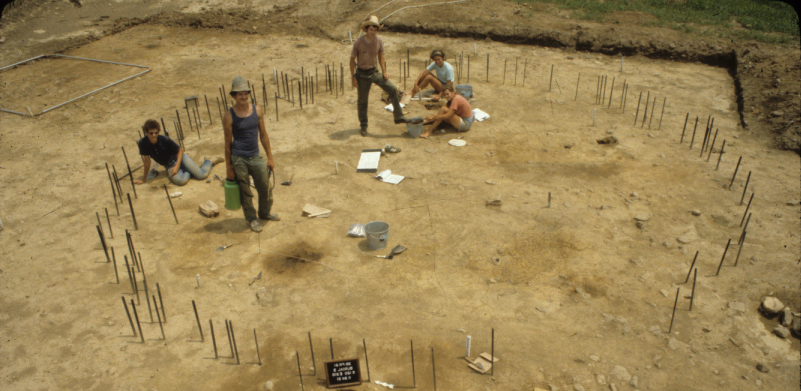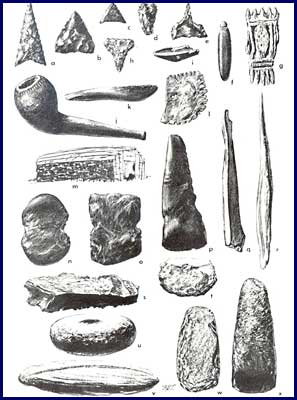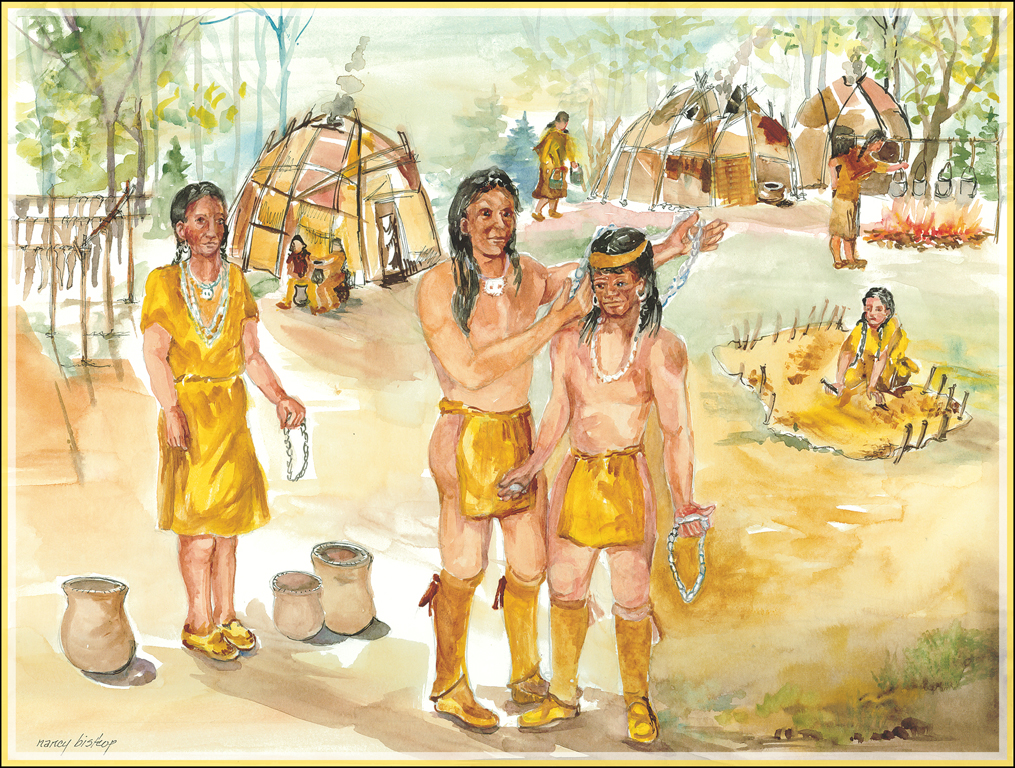Late Woodland
Late Prehistoric Period
The prehistory of the Upper Ohio Valley in Pennsylvania is closely related to cultural developments in Ohio, West Virginia and Indiana. It is very different than developments in eastern Pennsylvania and this is reflected in the chronological terms used to describe the cultures of the region. The Late Prehistoric Period begins at approximately 1050 AD. The Monongahela were an agricultural people who lived in small circular houses organized in villages of up to several hundred people. A stockade wall of wooden poles frequently surrounded their villages and we assume they were involved in a feuding type of warfare with other native groups. They grew corn, beans, and squash, but also relied on hunting and gathering wild foods. The bow and arrow was their standard hunting tool. Shellfish was also an important resource. Since the Monongahela people had no chemical fertilizers, they needed to move their villages every few years as the soil became depleted of nutrients. Charred remains of corn are found in refuse pits, along with bone and shell debris. In addition to stone tools and pottery, a wide variety of ornamental artifacts are found at Monongahela village sites, including bone beads, ornaments of carved bone and teeth, and marine shell pendants. Stone and ceramic smoking pipes are also common.
Late Woodland Period
The Late Woodland Period in the Susquehanna and Delaware Valleys, at approximately 1050 BP., is characterized by well-made pottery, the widespread use of triangular arrow points, and most groups were involved in a mixed food economy involving horticulture, hunting, fishing, and gathering. Settlements were more permanent and may have involved year-round occupations. Pottery is thinner, more durable, and characterized by a variety of incised geometric designs on the rim sections. Archaeologists are able to assign names to regional pottery styles and assume that they represent distinct cultural, ethnic or tribal groups.

Postmold patterns show a circular house at the Fort Loudon site
In eastern Pennsylvania, habitation sites that date between 950 and 1250 AD usually contain one or two houses of a size that would hold a large nuclear family. This suggests that the population was dispersed into widely spaced farmsteads. Known as the Clemson Island culture, these people were growing corn and squash and later beans. Burial mounds have been found from this time period in the central Susquehanna and Juniata River valleys, so people must have joined into larger groups periodically to maintain these mounds. In addition to habitation sites, there are also many small sites in upland settings that represent short-term camps for fishing, hunting, or gathering plant foods.
After 1250 AD in the Susquehanna Valley, the scattered homesteads coalesced into clusters of houses. In the Lower Susquehanna Valley, the Shenks Ferry culture evolved, and by 1450 AD their villages were stockaded, covering four acres and including over 60 nuclear-family sized houses. Houses were organized around a central plaza that sometimes contained a large circular structure that was likely used for community activities and ceremonies. Based on the house size and our knowledge of small farming cultures, these people were probably patrilineal in their social organization, that is, family relationships were defined through the father's side of the family. Fields containing corn, beans, and squash surrounded the villages. The villages were moved approximately every decade as the soil fertility was depleted. Burials were scattered throughout the village, although most frequently situated between the outer ring of houses and the stockade. The stockades suggest that there may have been feuding between villages, but villages were also probably being threatened by outsiders. Based on their houses and ethnographic evidence, they may have spoken an Algonquian language. Their ancestors had probably lived in the valley for hundreds or even thousands of years.
In the Delaware River Valley, the pattern of small homesteads and hamlets continued until European contact. Unlike other regions, there is no evidence for large, stockaded villages. The Late Woodland complexes of this region are identified by pottery styles termed Minguannan and Overpeck. We assume that they represent slightly different cultural groups. Although agriculture was practiced, it appears to have been less important than in regions to the west. It is notable that farming requires more effort than gathering wild foods. In the Delaware Valley, it is possible that wild plant foods were abundant relative to population density and there may have been little reason to make the change to farming.
The Minguannan were ancestral to the Delaware, who occupied the region at the time of European contact. Based on historical accounts, the Delaware were matrilineal, and their houses were occupied by a group of sisters, female cousins, and their families. They had different house forms during different times of the year. Multi-family longhouses, occupied during the winter, could be over 100 feet long. Groups were smaller and more mobile in the summer, often living in small houses near agricultural fields. The Delaware are prominent in the history of William Penn and the founding of Pennsylvania but are poorly documented in the archaeological record.
The Late Woodland Period is a time of social and economic change. Native Americans become more settled, first moving into scattered homesteads, then to larger collections of houses, and finally into stockaded villages. Warfare or feuding between villages seems to be widespread by AD 1550. With the arrival of Europeans and competition for their goods, warfare, and disease begin the destruction of Native American populations. Each of the tribes in Pennsylvania seems to have a different experience with the Europeans, but in the end, their cultures are destroyed.

Late Woodland artifacts from the Delaware River Valley, from Archaeology in the Upper Delaware Valley, by W. Fred Kinsey (1972)
